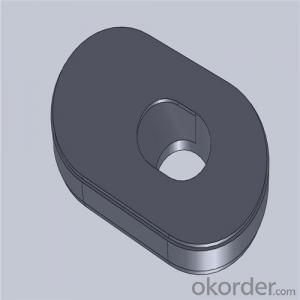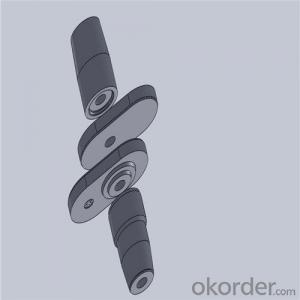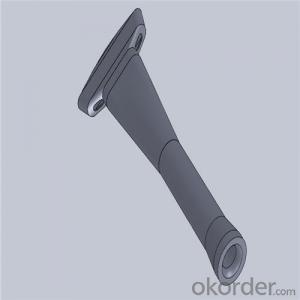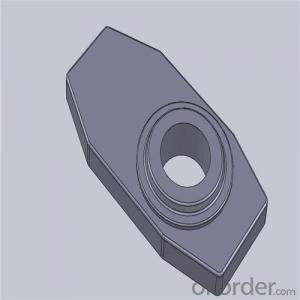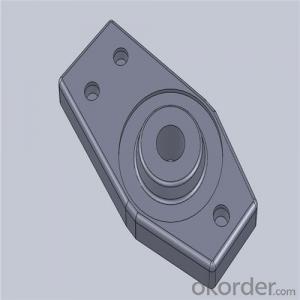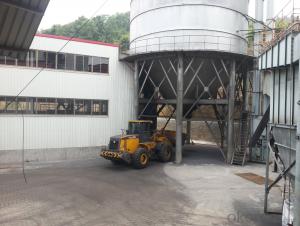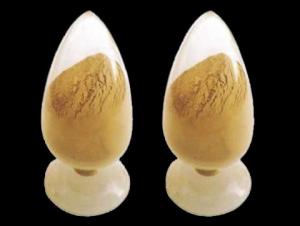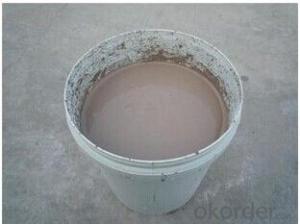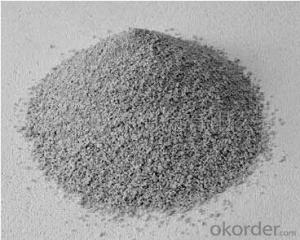High Performance&Temperature Ladle Sliding Gate Steel Industry
- Loading Port:
- Shanghai
- Payment Terms:
- TT OR LC
- Min Order Qty:
- 100 pc
- Supply Capability:
- 1000 pc/month
OKorder Service Pledge
OKorder Financial Service
You Might Also Like
Quick Details for High Performance Refractory Ladle Slide Gate
| Place of Origin: | China (Mainland) | Shape: | Plate | Material: | Alumina Block |
| SiO2 Content (%): | N/A | Al2O3 Content (%): | 80-90% | MgO Content (%): | N/A |
| CaO Content (%): | N/A | Refractoriness (Degree): | 1770°< Refractoriness< 2000° | CrO Content (%): | N/A |
| SiC Content (%): | N/A | Model Number: | CS80 | Brand Name: | |
| Product name: | High performance refractory ladle slide gate | Model No.: | cs80 | Brand name: | CMAX |
| Quality: | Al-C or Al-Zr-C | Service life: | 4-6 heats | Apparent porosity: | 7% Max |
| Bulk density:: | 3.1 MIN | C.C.S: | 120MPA | MOQ: | 100 pcs for trial |
| Delivery time: | 60 working days upon receipt of deposit |
Packaging & Delivery
| Packaging Details: | Inner carton packing, outer wooden case suitable for long term sea shipping |
| Delivery Detail: | three months working days upon receipt of deposit |
Specifications
Surface flatness less than 0.05mm
High mechanical strength
Erosion resistance
Oxidation resistance
Thermal shock stability
Slide gate plate widely including Alumina carbon and Alumina Zirconia Carbon slide gate plate, MgO and MgO-spinel slide gate plate,nonoxides bonding slide gate plateand unburned slide gate plate.
General Chemical Analysis for refractory ladle slide gate :
Alumina -Zirconia-Carbon material
| Al-Zr-C Material | |||||
| Al2O3 | C | ZrO2 | Apparent porosity | Bulk density | C.C.S |
| (% minm) | (% minm) | (% minm) | (% max) | (gm./cc minm) | (MPa minm) |
| 85 | 3 | 5 | 7 | 3.1 | 120 |
| 85 | 3 | 4 | 7 | 3.1 | 120 |
Composite type: Al-Zr-C for working line, outer Al-C material
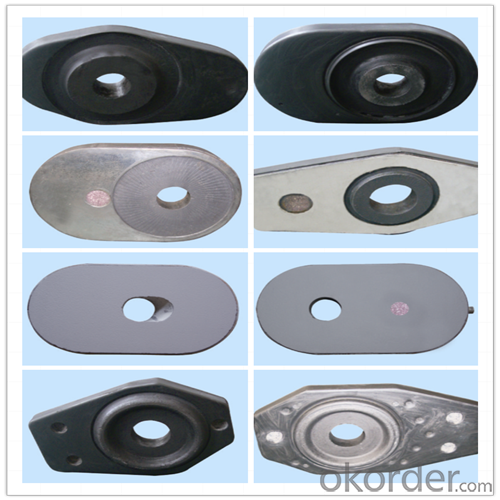
| Al-Zr-C & Al-C Material | ||||||
| Al2O3 | C | ZrO2 | Apparent porosity | Bulk density | C.C.S | |
| (% minm) | (% minm) | (% minm) | (% max) | (gm./cc minm) | (MPa minm) | |
| Inner side (Working face) | 85 | 3 | 4 | 7 | 3.1 | 120 |
| Outside | 90 | 3 | 0 | 9 | 3 | |

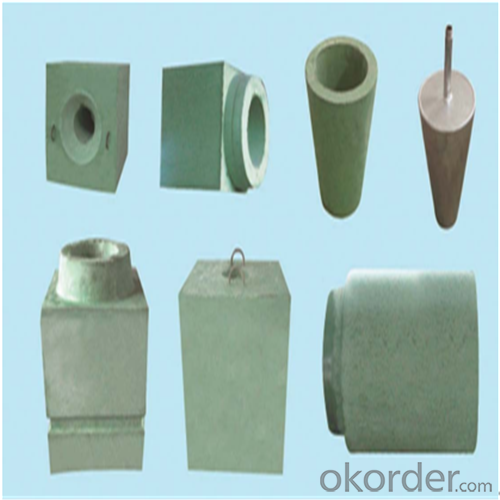
About us

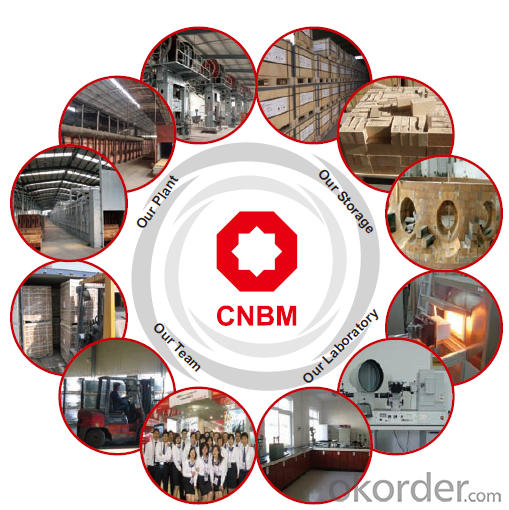
Sample is on your request.
Welcome to visit our factory~
- Q:How do monolithic refractories contribute to the overall efficiency of steel ladle operations?
- Monolithic refractories play a crucial role in enhancing the overall efficiency of steel ladle operations. These refractories are engineered materials that are installed as a single, unbroken structure within the ladle. They offer numerous benefits that directly contribute to the efficiency of the steel ladle operations. Firstly, monolithic refractories are known for their excellent thermal insulation properties. They have low thermal conductivity, which means they can effectively retain and contain heat within the ladle. This insulation property helps in maintaining the desired temperature of the molten steel, preventing heat loss during transportation and reducing the need for frequent reheating. By minimizing heat loss, monolithic refractories enable more efficient use of energy resources, resulting in cost savings and improved productivity. Additionally, monolithic refractories exhibit high refractoriness, which refers to their ability to withstand high temperatures without losing their structural integrity. This characteristic is vital in steel ladle operations, as the ladles are exposed to extreme temperatures during the steelmaking process. The high refractoriness of monolithic refractories ensures that they can withstand the intense heat and prevent any damage or failure of the ladle lining. This durability translates into reduced downtime and maintenance requirements, leading to increased operational efficiency. Moreover, monolithic refractories offer excellent resistance to chemical attack. The ladles used in steelmaking are in contact with various corrosive substances, such as molten metals, slag, and fluxes. The chemical resistance of monolithic refractories prevents them from reacting with these substances, ensuring the integrity and longevity of the ladle lining. This resistance to chemical attack reduces the frequency of repairs and replacements, minimizing downtime and improving the overall efficiency of ladle operations. Furthermore, the installation of monolithic refractories is relatively quick and straightforward compared to traditional brick linings. This ease of installation saves time and labor costs, allowing for faster turnaround between ladle operations. It enables steel manufacturers to optimize their production schedules and enhance overall operational efficiency. In conclusion, monolithic refractories contribute significantly to the overall efficiency of steel ladle operations. Their excellent thermal insulation properties, high refractoriness, resistance to chemical attack, and ease of installation all play vital roles in improving energy efficiency, reducing downtime, and enhancing productivity. By choosing monolithic refractories, steel manufacturers can achieve optimized ladle performance and ultimately improve their overall steelmaking process.
- Q:How do monolithic refractories contribute to energy efficiency in iron and steel production?
- Monolithic refractories contribute to energy efficiency in iron and steel production by providing superior insulation and heat containment properties. These refractories have low thermal conductivity, which minimizes heat loss and ensures that the intense temperatures required for the production process are maintained within the furnace or kiln. This reduces the need for excessive fuel consumption and enables more efficient use of energy resources. Additionally, monolithic refractories can withstand high temperatures without significant structural damage, prolonging their lifespan and reducing the frequency of replacement, further contributing to energy efficiency in the industry.
- Q:What are the advantages of using low-moisture castables in the iron and steel industry?
- Low-moisture castables offer several advantages in the iron and steel industry. Firstly, they have a lower water content, which allows for faster and easier installation. This results in reduced downtime and increased productivity. Secondly, low-moisture castables have excellent strength and thermal shock resistance, making them highly durable in high-temperature applications. This helps to prolong the lifespan of refractory linings, saving on maintenance and replacement costs. Additionally, their low moisture content minimizes the risk of steam explosions during installation or curing. Lastly, these castables offer improved energy efficiency by reducing heat loss, resulting in lower fuel consumption and greenhouse gas emissions. Overall, the use of low-moisture castables in the iron and steel industry enhances operational efficiency, durability, and environmental sustainability.
- Q:What are the common applications of monolithic refractories in blast furnaces?
- Monolithic refractories are commonly used in blast furnaces for various applications such as lining and repairing the hearth, taphole, and slag line, as well as for hot repairs and maintenance. These refractories provide high-temperature resistance, erosion and corrosion resistance, and thermal shock resistance, thereby ensuring the efficient and reliable operation of blast furnaces in the iron and steel industry.
- Q:What are the key properties of patching mixes used for monolithic refractory repairs?
- The key properties of patching mixes used for monolithic refractory repairs include high thermal conductivity, excellent adhesion, good workability, high strength, resistance to thermal shock, and suitable setting and drying times. These properties ensure effective repairs and long-lasting performance in high-temperature applications.
- Q:How do monolithic refractories prevent thermal radiation in the iron and steel industry?
- Monolithic refractories play a vital role in the iron and steel industry by preventing thermal radiation. Thermal radiation is the transfer of heat energy through electromagnetic waves and poses a significant challenge due to the industry's high temperatures. Monolithic refractories are refractory materials that come in a single piece and are designed with exceptional thermal insulation properties. They have low thermal conductivity, meaning they do not conduct heat well. This quality allows them to act as a barrier against thermal radiation. In the iron and steel industry, monolithic refractories are commonly used as linings in furnaces, ladles, and other equipment exposed to extreme temperatures. These linings act as protective layers, preventing heat from escaping and reducing the emission of thermal radiation. Furthermore, monolithic refractories have high emissivity, which means they can absorb and re-emit thermal radiation effectively. This characteristic enables them to capture and contain heat within the equipment, minimizing the amount of radiation that escapes into the surroundings. By preventing thermal radiation, monolithic refractories help maintain the desired temperatures during the iron and steel production process. This is crucial for achieving efficient and controlled operations, as well as ensuring the quality of the final products. Moreover, the use of monolithic refractories in the iron and steel industry also contributes to energy savings. By reducing heat loss through thermal radiation, less energy is needed to maintain the desired temperatures, resulting in lower energy consumption and cost savings. In conclusion, monolithic refractories are indispensable for preventing thermal radiation in the iron and steel industry. Their excellent thermal insulation properties, low thermal conductivity, and high emissivity make them effective barriers against heat transfer through radiation. By minimizing heat loss and ensuring controlled temperatures, monolithic refractories contribute to efficient operations, high-quality products, and energy savings.
- Q:How do monolithic refractories handle thermal expansion and contraction?
- Thermal expansion and contraction pose challenges that monolithic refractories are specifically designed to tackle. Unlike traditional brick or tile refractories, these materials are composed of a single solid structure. This unique composition allows them to better accommodate the thermal stresses associated with temperature changes. One method employed by monolithic refractories to manage thermal expansion and contraction is their ability to endure high temperatures. These materials are engineered to have a high melting point, enabling them to preserve their structural integrity even in extreme heat conditions. This characteristic prevents them from cracking or disintegrating due to thermal expansion. Additionally, monolithic refractories often contain a binder or bonding agent that holds the refractory particles together. This binder can be formulated to possess a certain level of flexibility, enabling the material to expand and contract without incurring cracks or breaks. This flexibility aids in absorbing the stresses caused by thermal expansion and contraction, ensuring the long-lasting performance of the refractory. Furthermore, monolithic refractories can be applied in a manner that allows for expansion and contraction. Installers can leave joints or gaps between sections, which accommodate the movement caused by temperature changes. This technique, referred to as joint design or expansion joint systems, permits the refractory to expand and contract without causing any harm to the overall structure. Overall, monolithic refractories are designed to handle thermal expansion and contraction by withstanding high temperatures, incorporating flexible binders, and employing joint design techniques. These properties enable them to maintain their structural integrity and performance in extreme heat conditions, making them a reliable choice for applications that necessitate resistance to thermal stress.
- Q:What are the key properties of shotcrete mixes used for monolithic refractory applications?
- The key properties of shotcrete mixes used for monolithic refractory applications include high strength, low porosity, high abrasion resistance, good thermal shock resistance, and excellent adhesion to the substrate. These properties ensure the durability and effectiveness of the shotcrete in withstanding high temperatures and harsh conditions in refractory applications.
- Q:How do monolithic refractories improve the efficiency of reheating furnaces in steel plants?
- Monolithic refractories play a crucial role in improving the efficiency of reheating furnaces in steel plants. These refractories are specially designed to withstand high temperatures and harsh operating conditions, making them ideal for use in steel plants. One of the key ways in which monolithic refractories enhance furnace efficiency is by reducing heat loss. These refractories have excellent insulation properties, which help to minimize heat transfer from the furnace to its surroundings. As a result, less energy is wasted, and the furnace can maintain its desired temperature more efficiently. Additionally, monolithic refractories contribute to a more uniform and controlled heat distribution within the furnace. They can be easily shaped and installed to create a seamless lining, ensuring that heat is evenly distributed throughout the furnace chamber. This uniform heat distribution prevents hotspots and cold spots, leading to a more efficient heating process. Monolithic refractories also play a crucial role in minimizing downtime and maintenance requirements. Unlike traditional brick linings, which are prone to cracking and erosion, monolithic refractories offer superior resistance to wear and tear. This enhanced durability reduces the need for frequent repairs and replacements, allowing for uninterrupted furnace operation and increased overall efficiency. Furthermore, monolithic refractories contribute to improved energy efficiency by reducing fuel consumption. The superior insulation properties of these refractories help to retain heat within the furnace, reducing the amount of energy required to maintain the desired temperature. This leads to significant energy savings for steel plants, as less fuel is needed to achieve the same heating results. In conclusion, monolithic refractories significantly improve the efficiency of reheating furnaces in steel plants by reducing heat loss, ensuring uniform heat distribution, minimizing downtime and maintenance, and reducing fuel consumption. By incorporating these refractories into their furnace linings, steel plants can enhance their productivity, reduce energy costs, and improve the overall efficiency of their operations.
- Q:Can monolithic refractories be used for the lining of continuous casting tundishes and molds?
- Yes, monolithic refractories can be used for the lining of continuous casting tundishes and molds. Monolithic refractories are a type of refractory material that is composed of a single, homogeneous structure, in contrast to traditional refractories that are made up of multiple bricks or tiles. Monolithic refractories offer several advantages for lining tundishes and molds in continuous casting processes. Firstly, their monolithic nature allows for easy installation and repair, as they can be cast or gunned into place, eliminating the need for complex brickwork. This results in reduced downtime and increased productivity. Additionally, monolithic refractories have excellent thermal shock resistance, which is crucial for tundishes and molds that experience rapid and extreme temperature changes during the casting process. Their high thermal conductivity also ensures efficient heat transfer, promoting uniform cooling and solidification of the cast metal. Moreover, monolithic refractories offer good resistance to chemical attack, ensuring long-lasting performance even in the presence of molten metal and slag. They also have low porosity, preventing the penetration of metal and preventing the formation of cracks and spalling. Overall, monolithic refractories are a viable and effective choice for lining continuous casting tundishes and molds, providing superior performance, ease of installation, and durability in the demanding conditions of the casting process.
1. Manufacturer Overview |
|
|---|---|
| Location | |
| Year Established | |
| Annual Output Value | |
| Main Markets | |
| Company Certifications | |
2. Manufacturer Certificates |
|
|---|---|
| a) Certification Name | |
| Range | |
| Reference | |
| Validity Period | |
3. Manufacturer Capability |
|
|---|---|
| a)Trade Capacity | |
| Nearest Port | |
| Export Percentage | |
| No.of Employees in Trade Department | |
| Language Spoken: | |
| b)Factory Information | |
| Factory Size: | |
| No. of Production Lines | |
| Contract Manufacturing | |
| Product Price Range | |
Send your message to us
High Performance&Temperature Ladle Sliding Gate Steel Industry
- Loading Port:
- Shanghai
- Payment Terms:
- TT OR LC
- Min Order Qty:
- 100 pc
- Supply Capability:
- 1000 pc/month
OKorder Service Pledge
OKorder Financial Service
Similar products
New products
Hot products
Related keywords

